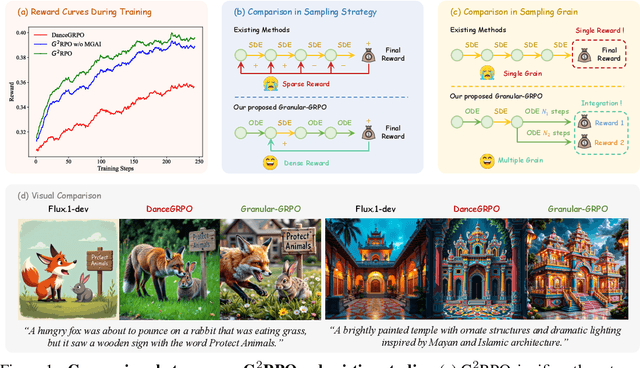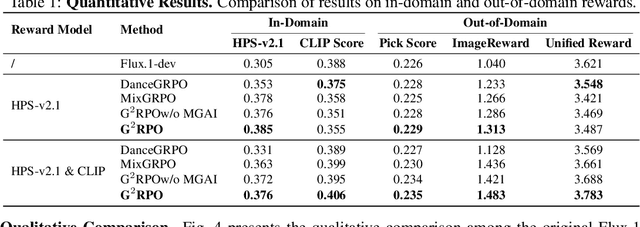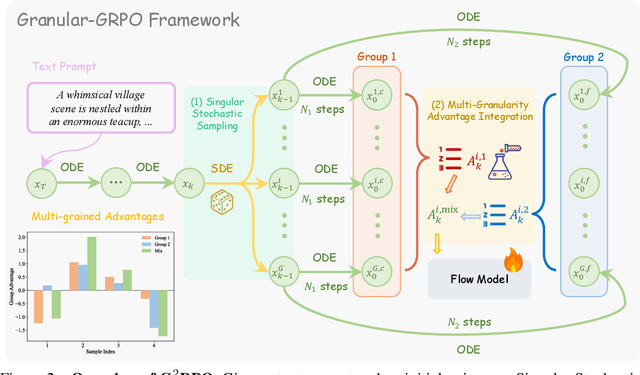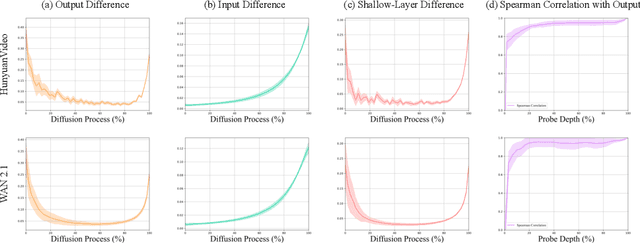Yibin Wang
$\text{G}^2$RPO: Granular GRPO for Precise Reward in Flow Models
Oct 02, 2025



Abstract:The integration of online reinforcement learning (RL) into diffusion and flow models has recently emerged as a promising approach for aligning generative models with human preferences. Stochastic sampling via Stochastic Differential Equations (SDE) is employed during the denoising process to generate diverse denoising directions for RL exploration. While existing methods effectively explore potential high-value samples, they suffer from sub-optimal preference alignment due to sparse and narrow reward signals. To address these challenges, we propose a novel Granular-GRPO ($\text{G}^2$RPO ) framework that achieves precise and comprehensive reward assessments of sampling directions in reinforcement learning of flow models. Specifically, a Singular Stochastic Sampling strategy is introduced to support step-wise stochastic exploration while enforcing a high correlation between the reward and the injected noise, thereby facilitating a faithful reward for each SDE perturbation. Concurrently, to eliminate the bias inherent in fixed-granularity denoising, we introduce a Multi-Granularity Advantage Integration module that aggregates advantages computed at multiple diffusion scales, producing a more comprehensive and robust evaluation of the sampling directions. Experiments conducted on various reward models, including both in-domain and out-of-domain evaluations, demonstrate that our $\text{G}^2$RPO significantly outperforms existing flow-based GRPO baselines,highlighting its effectiveness and robustness.
Towards Confidential and Efficient LLM Inference with Dual Privacy Protection
Sep 11, 2025Abstract:CPU-based trusted execution environments (TEEs) and differential privacy (DP) have gained wide applications for private inference. Due to high inference latency in TEEs, researchers use partition-based approaches that offload linear model components to GPUs. However, dense nonlinear layers of large language models (LLMs) result in significant communication overhead between TEEs and GPUs. DP-based approaches apply random noise to protect data privacy, but this compromises LLM performance and semantic understanding. To overcome the above drawbacks, this paper proposes CMIF, a Confidential and efficient Model Inference Framework. CMIF confidentially deploys the embedding layer in the client-side TEE and subsequent layers on GPU servers. Meanwhile, it optimizes the Report-Noisy-Max mechanism to protect sensitive inputs with a slight decrease in model performance. Extensive experiments on Llama-series models demonstrate that CMIF reduces additional inference overhead in TEEs while preserving user data privacy.
An U-Net-Based Deep Neural Network for Cloud Shadow and Sun-Glint Correction of Unmanned Aerial System (UAS) Imagery
Sep 10, 2025Abstract:The use of unmanned aerial systems (UASs) has increased tremendously in the current decade. They have significantly advanced remote sensing with the capability to deploy and image the terrain as per required spatial, spectral, temporal, and radiometric resolutions for various remote sensing applications. One of the major advantages of UAS imagery is that images can be acquired in cloudy conditions by flying the UAS under the clouds. The limitation to the technology is that the imagery is often sullied by cloud shadows. Images taken over water are additionally affected by sun glint. These are two pose serious issues for estimating water quality parameters from the UAS images. This study proposes a novel machine learning approach first to identify and extract regions with cloud shadows and sun glint and separate such regions from non-obstructed clear sky regions and sun-glint unaffected regions. The data was extracted from the images at pixel level to train an U-Net based deep learning model and best settings for model training was identified based on the various evaluation metrics from test cases. Using this evaluation, a high-quality image correction model was determined, which was used to recover the cloud shadow and sun glint areas in the images.
Pref-GRPO: Pairwise Preference Reward-based GRPO for Stable Text-to-Image Reinforcement Learning
Aug 28, 2025Abstract:Recent advancements highlight the importance of GRPO-based reinforcement learning methods and benchmarking in enhancing text-to-image (T2I) generation. However, current methods using pointwise reward models (RM) for scoring generated images are susceptible to reward hacking. We reveal that this happens when minimal score differences between images are amplified after normalization, creating illusory advantages that drive the model to over-optimize for trivial gains, ultimately destabilizing the image generation process. To address this, we propose Pref-GRPO, a pairwise preference reward-based GRPO method that shifts the optimization objective from score maximization to preference fitting, ensuring more stable training. In Pref-GRPO, images are pairwise compared within each group using preference RM, and the win rate is used as the reward signal. Extensive experiments demonstrate that PREF-GRPO differentiates subtle image quality differences, providing more stable advantages and mitigating reward hacking. Additionally, existing T2I benchmarks are limited by coarse evaluation criteria, hindering comprehensive model assessment. To solve this, we introduce UniGenBench, a unified T2I benchmark comprising 600 prompts across 5 main themes and 20 subthemes. It evaluates semantic consistency through 10 primary and 27 sub-criteria, leveraging MLLM for benchmark construction and evaluation. Our benchmarks uncover the strengths and weaknesses of both open and closed-source T2I models and validate the effectiveness of Pref-GRPO.
DiCache: Let Diffusion Model Determine Its Own Cache
Aug 24, 2025



Abstract:Recent years have witnessed the rapid development of acceleration techniques for diffusion models, especially caching-based acceleration methods. These studies seek to answer two fundamental questions: "When to cache" and "How to use cache", typically relying on predefined empirical laws or dataset-level priors to determine the timing of caching and utilizing handcrafted rules for leveraging multi-step caches. However, given the highly dynamic nature of the diffusion process, they often exhibit limited generalizability and fail on outlier samples. In this paper, a strong correlation is revealed between the variation patterns of the shallow-layer feature differences in the diffusion model and those of final model outputs. Moreover, we have observed that the features from different model layers form similar trajectories. Based on these observations, we present DiCache, a novel training-free adaptive caching strategy for accelerating diffusion models at runtime, answering both when and how to cache within a unified framework. Specifically, DiCache is composed of two principal components: (1) Online Probe Profiling Scheme leverages a shallow-layer online probe to obtain a stable prior for the caching error in real time, enabling the model to autonomously determine caching schedules. (2) Dynamic Cache Trajectory Alignment combines multi-step caches based on shallow-layer probe feature trajectory to better approximate the current feature, facilitating higher visual quality. Extensive experiments validate DiCache's capability in achieving higher efficiency and improved visual fidelity over state-of-the-art methods on various leading diffusion models including WAN 2.1, HunyuanVideo for video generation, and Flux for image generation.
GeometryZero: Improving Geometry Solving for LLM with Group Contrastive Policy Optimization
Jun 08, 2025Abstract:Recent advances in large language models (LLMs) have demonstrated remarkable capabilities across diverse domains, particularly in mathematical reasoning, amid which geometry problem solving remains a challenging area where auxiliary construction plays a enssential role. Existing approaches either achieve suboptimal performance or rely on massive LLMs (e.g., GPT-4o), incurring massive computational costs. We posit that reinforcement learning with verifiable reward (e.g., GRPO) offers a promising direction for training smaller models that effectively combine auxiliary construction with robust geometric reasoning. However, directly applying GRPO to geometric reasoning presents fundamental limitations due to its dependence on unconditional rewards, which leads to indiscriminate and counterproductive auxiliary constructions. To address these challenges, we propose Group Contrastive Policy Optimization (GCPO), a novel reinforcement learning framework featuring two key innovations: (1) Group Contrastive Masking, which adaptively provides positive or negative reward signals for auxiliary construction based on contextual utility, and a (2) length reward that promotes longer reasoning chains. Building on GCPO, we develop GeometryZero, a family of affordable-size geometric reasoning models that judiciously determine when to employ auxiliary construction. Our extensive empirical evaluation across popular geometric benchmarks (Geometry3K, MathVista) demonstrates that GeometryZero models consistently outperform baselines (e.g. GRPO), achieving an average improvement of 4.29% across all benchmarks.
Improving Data Efficiency for LLM Reinforcement Fine-tuning Through Difficulty-targeted Online Data Selection and Rollout Replay
Jun 05, 2025Abstract:Reinforcement learning (RL) has become an effective approach for fine-tuning large language models (LLMs), particularly to enhance their reasoning capabilities. However, RL fine-tuning remains highly resource-intensive, and existing work has largely overlooked the problem of data efficiency. In this paper, we propose two techniques to improve data efficiency in LLM RL fine-tuning: difficulty-targeted online data selection and rollout replay. We introduce the notion of adaptive difficulty to guide online data selection, prioritizing questions of moderate difficulty that are more likely to yield informative learning signals. To estimate adaptive difficulty efficiently, we develop an attention-based framework that requires rollouts for only a small reference set of questions. The adaptive difficulty of the remaining questions is then estimated based on their similarity to this set. To further reduce rollout cost, we introduce a rollout replay mechanism that reuses recent rollouts, lowering per-step computation while maintaining stable updates. Extensive experiments across 6 LLM-dataset combinations show that our method reduces RL fine-tuning time by 25% to 65% to reach the same level of performance as the original GRPO algorithm.
Token-Level Uncertainty Estimation for Large Language Model Reasoning
May 16, 2025Abstract:While Large Language Models (LLMs) have demonstrated impressive capabilities, their output quality remains inconsistent across various application scenarios, making it difficult to identify trustworthy responses, especially in complex tasks requiring multi-step reasoning. In this paper, we propose a token-level uncertainty estimation framework to enable LLMs to self-assess and self-improve their generation quality in mathematical reasoning. Specifically, we introduce low-rank random weight perturbation to LLM decoding, generating predictive distributions that we use to estimate token-level uncertainties. We then aggregate these uncertainties to reflect semantic uncertainty of the generated sequences. Experiments on mathematical reasoning datasets of varying difficulty demonstrate that our token-level uncertainty metrics strongly correlate with answer correctness and model robustness. Additionally, we explore using uncertainty to directly enhance the model's reasoning performance through multiple generations and the particle filtering algorithm. Our approach consistently outperforms existing uncertainty estimation methods, establishing effective uncertainty estimation as a valuable tool for both evaluating and improving reasoning generation in LLMs.
Efficient Uncertainty Estimation via Distillation of Bayesian Large Language Models
May 16, 2025Abstract:Recent advances in uncertainty estimation for Large Language Models (LLMs) during downstream adaptation have addressed key challenges of reliability and simplicity. However, existing Bayesian methods typically require multiple sampling iterations during inference, creating significant efficiency issues that limit practical deployment. In this paper, we investigate the possibility of eliminating the need for test-time sampling for LLM uncertainty estimation. Specifically, when given an off-the-shelf Bayesian LLM, we distill its aligned confidence into a non-Bayesian student LLM by minimizing the divergence between their predictive distributions. Unlike typical calibration methods, our distillation is carried out solely on the training dataset without the need of an additional validation dataset. This simple yet effective approach achieves N-times more efficient uncertainty estimation during testing, where N is the number of samples traditionally required by Bayesian LLMs. Our extensive experiments demonstrate that uncertainty estimation capabilities on training data can successfully generalize to unseen test data through our distillation technique, consistently producing results comparable to (or even better than) state-of-the-art Bayesian LLMs.
Unified Multimodal Chain-of-Thought Reward Model through Reinforcement Fine-Tuning
May 06, 2025Abstract:Recent advances in multimodal Reward Models (RMs) have shown significant promise in delivering reward signals to align vision models with human preferences. However, current RMs are generally restricted to providing direct responses or engaging in shallow reasoning processes with limited depth, often leading to inaccurate reward signals. We posit that incorporating explicit long chains of thought (CoT) into the reward reasoning process can significantly strengthen their reliability and robustness. Furthermore, we believe that once RMs internalize CoT reasoning, their direct response accuracy can also be improved through implicit reasoning capabilities. To this end, this paper proposes UnifiedReward-Think, the first unified multimodal CoT-based reward model, capable of multi-dimensional, step-by-step long-chain reasoning for both visual understanding and generation reward tasks. Specifically, we adopt an exploration-driven reinforcement fine-tuning approach to elicit and incentivize the model's latent complex reasoning ability: (1) We first use a small amount of image generation preference data to distill the reasoning process of GPT-4o, which is then used for the model's cold start to learn the format and structure of CoT reasoning. (2) Subsequently, by leveraging the model's prior knowledge and generalization capabilities, we prepare large-scale unified multimodal preference data to elicit the model's reasoning process across various vision tasks. During this phase, correct reasoning outputs are retained for rejection sampling to refine the model (3) while incorrect predicted samples are finally used for Group Relative Policy Optimization (GRPO) based reinforcement fine-tuning, enabling the model to explore diverse reasoning paths and optimize for correct and robust solutions. Extensive experiments across various vision reward tasks demonstrate the superiority of our model.
 Add to Chrome
Add to Chrome Add to Firefox
Add to Firefox Add to Edge
Add to Edge